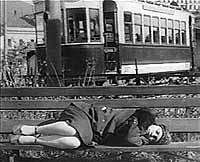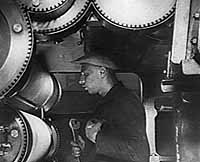 
As dawn lights up the city, a woman wakes on a park bench
and a worker inspects machinery in Man With a Movie Camera.
Vertov created a reality that was different from the perceptible world because it was dependent upon the very materials which recorded it. In Man With a Movie Camera, he shows himself in the cutting-room, constructing his film, and records his brother, the cameraman, filming the shot that has just been shown. He even shoots his own movie as it’s being projected in a theater, so we can see the screen itself and, at times, the audience watching it. In one shot, we see a group of workers approaching the foreground and moving around something on the ground. In the next shot, we see the actual man with the movie camera and realize that this is the object the workers are trying to avoid. Just four years before Busby Berkeley’s bubbly broads burst onto 42nd Street, Vertov’s film
Man With a Movie Camera showed audiences how people could learn to love the machine in the name of the body politic.
Meanwhile, in America, New York City was the darling metropolis. It was urbane and desperate at the same time and artists wanted to tap into the contradictory energy that was catapulting New York’s cityscape into the clouds. One only had to look up to be reminded that the shape of multi-storied buildings was synonymous with advancement. Though America hadn’t participated in Paris’ 1925 Exposition, European immigrants traveled to New York in steamships with the secrets of Art Deco safely stored in their trunks. The angles and lines of the new style were custom-made for the height and presence of New York’s skyscrapers and the buildings quickly became emblems of expectation.
The stock market Crash of 1929 put a damper on the frivolity of the twenties and society had assumed a more somber tone. To match this climate, the decorative arts became more purposeful and styles grew as hardened as the poor folk who were forced to shed the bearable burden of prosperity. Fashions became severe in order to promote an exterior of rigidity and economy. The city was inundated with clean lines, rounded corners and muted colors. This style was called "streamlining" and as the thirties progressed, few objects or buildings would escape designers’ hands without being streamlined.
...streamlining was a form of symbolic packaging, a visual metaphor of aspiration and progress. It suggested a people who were not content to remain static in the doldrums, but were determined to ride forward, as fast as possible, into a shining future. Perhaps society, too, could be engineered into something smooth and frictionless. [Hillier, p.105-107]
American art had developed a social conscience like that of the Soviet state, but in the hands of movie musical monarch Busby Berkeley, it would express itself with a very different vigor.
page 2 of 3
 
|


